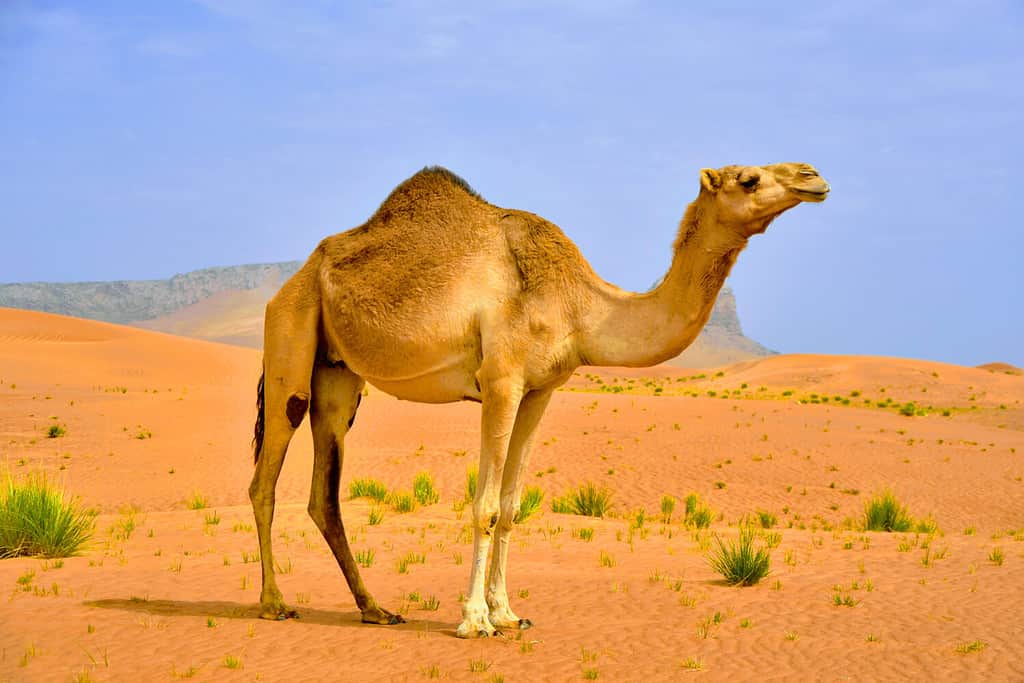Many people are familiar with these giant creatures that live in arid environments of open deserts. Camels are most recognizable for their humps that store fat. These animals reach up to 11.5 feet in length and over 1,000 pounds. With that massive size comes immense strength. Let’s discover how much weight a camel can carry and various fun facts about this incredible creature.
How Much Weight Can a Camel Carry?

Camels have been transporting people and goods for years. Without them, many civilizations would not have survived.
©givaga/Shutterstock.com
Camels are known for their size and strength. With camels reaching up to seven feet tall and over 1,300 pounds, it is no surprise that they can carry loads of great weight. Camels can carry up to 990 pounds! The strong muscles in their legs, and throughout their bodies, help them to do so. Although camels can carry that amount, it is not a typical cargo weight. On average, camels usually carry cargo that weighs about 300 pounds.
Facts About Camel Strength
Camels Have a Max Weight Load of Nearly 1,000 Pounds
As previously mentioned, although uncommon, camels can carry loads up to 990 pounds! While this is not the normal cargo weight that working camels are asked to carry, it is incredible to think that this animal can move freely with almost 1,000 pounds of additional weight on its body!
Today, most camels are domesticated and mainly used for the transportation of goods. Their ability to store fat in their humps for long periods of time allows them to travel great distances. Camels also move at a slow pace, which helps them conserve their energy for handling the weight of the goods they are carrying. They can travel over 18 miles while carrying over 400 pounds on their bodies!
Camels Are Stronger Than Horses
Camels are not the only animals that are used for the transportation of people and goods. Horses are also another common choice. While both are strong, the camel wins in this category! Despite the fact that horses can reach up to 2,000 pounds — depending on the breed — and camels usually only weigh up to 1,320 pounds, camels can carry more weight. As mentioned before, camels can carry up to 990 pounds, and average between 300-400 pounds on a normal trek. Horses can carry up to 20% of their body weight. This means that the largest horse of 2,000 pounds could potentially carry up to 400 pounds, but no more!
Camels Need Rest and Recovery
Camels can carry those impressive weight loads, but they do not do so year-round. A typical cargo weight for the working camel is about 300 pounds. However, camels only work for six to eight months out of the year. In the remaining months, they are recuperating their strength so that they can stay healthy and work again in the future.
Camels Retire
Similarly to humans, working camels get to retire. The average lifespan of a camel is around 40 years. Camels use their impressive strength for a little more than half their lives. Domesticated camels work until they are 25. They are no longer used for work after this age.
Camel Basics

Dromedary camels are camels that feature one hump. They are the most common type of camel in the world.
©Shengyong Li/Shutterstock.com
Camels are unique animals because they can survive in climates that most others could not. Many civilizations have thrived because of this animal and what it can offer people. In addition to the use of camels in transportation, humans have used wool, meat, and milk from them for many years.
Camel Characteristics
The characteristic that camels are most well-known for is their hump. While some camels have one hump (the dromedary camel) others have two (the Bactrian camel). These humps help store important resources and nutrients for the camel. In addition to their humps, camels sport tan fur and large bodies.
Camel Diet
Although camels can occasionally be found chewing on bones, they are primarily herbivores. Their lips allow them to eat thick, prickly plants found in the desert. This is because their lips are leather-like, which helps protect them from the thorns that would hurt other animals who try to consume them. Camels also consume twigs, bushes, and dry grasses.
Camel Habitat
Camels live in arid environments and in deserts. They inhabit regions across Africa, The Middle East, China, India, Mongolia, and Australia. The New World camelids, or other members of the camel family, are found across the Americas. Those members include llamas, alpacas, vicuñas, and guanacos.
Different Camel Types
There are three types of camel. Although similar, each has its own characteristics and things that make it stand out among the others. Below is a table that will go over some key features of each type of camel.
| Camel Type | Scientific Name | Number of Humps | Places They Can Be Found |
|---|---|---|---|
| Bactrian camel | Camelus bractrianus | Two humps | Central Asia and area of Bactria |
| Dromedary/ Arabian camel | Camelus dromedarius | One hump | Middle East, South Asia, and the Sahara Desert |
| Wild Bactrian camel | Camelus ferus | Two humps | Mongolia and Northwest of China |
Camel Adaptations
Fur
One adaptation that camels have is their fur. Camels actually have two layers of fur. Not only does that help to keep them warm in the frigid desert nights, but it also offers a layer of protection from the strength of the desert sun. Their fur mimics the color of the sand, allowing them to blend in with their environment.
Body Temperature
Another way that camels survive the extreme weather of their habitat is with their humps. Camels use these humps to store fat and nutrients that are important to them. Storing the majority of their fat in their humps enables them to better regulate their body temperatures more efficiently. Unlike humans, camels do not sweat. Instead, they employ their humps for temperature regulation, and their fur acts as an insulation that safeguards them from heat.
Body Structure
Another way they beat the heat is with their body structure. While the sand in a desert can be scorching, camels are well-adapted to it. The bottoms of their feet contain heat-resistant pads so they can walk across the sand with ease. These pads can also be found on other parts of their bodies, such as their knees and elbows. Their long legs also help keep a good distance between them and the hot sand as they are walking. In addition, their chests and sternums are shaped in a way that allows airflow even when they are lying on the ground, preventing them from overheating.
Sand Protection
Besides being hot, sand can be a tricky environment to live in for other reasons. Camels have wide, two-toed feet that allow them to more easily distribute their weight. This prevents them from sinking into the sand so that they can move quickly and easily across the top of it. Besides their feet, their eyes, ears, and noses are equipped to deal with the sand as well!
Camels’ eyes have two adaptations that help protect them from the sand. First, camels have very long eyelashes. These long eyelashes help prevent sand and dust from flying into the camel’s eyes. If dust does make it past the eyelashes, the camels have a second line of defense. Camels have a third eyelid! This extra eyelid can be used to push debris out of the eyes.
Their noses and ears also contain little hairs that help stop dust and sand from entering. Camels can even close their nostrils fully to prevent sand from entering as well!
10 Incredible Camel Facts: Amazing Features Besides Strength

Camels easily walk across the desert because of their feet. Camels do not sink into the sand because their large, two-toed feet allow the camel’s weight to be easily distributed.
©iStock.com/Chalabala
- Camels can survive ten months without water!
- Camels are now almost fully extinct in the wild but have a large domesticated population.
- Camels have three stomachs!
- Camels can drink up to 53 gallons of water in three minutes.
- 94 percent of camels in the world today are one-humped dromedaries.
- Camels have unique red blood cells. Shaped like ovals, these blood cells allow blood to flow smoothly when the camel becomes dehydrated.
- Camels can growl! Their growl was used in the Star Wars movies as one of Chewbacca’s sounds!
- Camels save water through their noses! They cool their air before they breathe it out so that they do not lose the water vapor from their breath! The water is reabsorbed into the body instead!
- Camel’s milk is high in vitamin C and consuming it helps prevent diabetes!
- Bactrian camels are the only land mammals that can safely drink salt water!
Camel FAQs
Is there a weight limit on riding a camel?
While camels can carry massive loads of over 400 pounds, the average weight limit for camel riding is usually between 200-250 pounds. Each organization has its own weight limits so it is best to check their site. The reason behind the weight limit is due to the frequent stopping and reloading of the camels.
How long can a camel go without water?
A camel can survive without water for up to ten months.
What is the camel’s hump for?
Despite popular belief, the camel’s hump is not for storing water. Instead, the hump stores fat, which the camel uses for energy and nutrients when water and food are not readily available.
Can a camel outrun a horse?
Horses are faster than camels. Horses can reach up to 55 miles per hour, whereas camels can only reach up to 40 miles per hour. Camels are built for endurance rather than speed.
The photo featured at the top of this post is © Dudarev Mikhail/Shutterstock.com
Thank you for reading! Have some feedback for us? Contact the AZ Animals editorial team.







